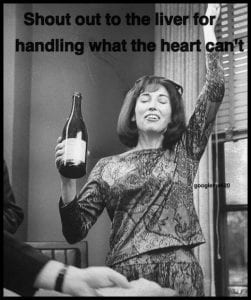Gone are those days when you would think excessive alcohol drinking was a man’s problem. The shift in excessive alcohol drinking patterns among women is on the rise particularly in younger age groups. Findings from the 2015 National Survey on Drug Use and Health estimated that about 5.3 million women suffer from Alcohol Use Disorder (AUD).
Women tolerate alcohol differently than men. Do you know why? Perhaps this may be since women have a lower body weight than men, less body water and higher percentage of body fat. In addition, women metabolize alcohol at a slower rate than men, so alcohol may remain in their tissues longer (1). There is evidence from studies that for equivalent doses of alcohol, women are more vulnerable than men to tissue damage and the onset of certain diseases such as cirrhosis of the liver and physical alcohol dependence (2). Heavier alcohol use by women is also thought to increase risk of bone fracture and osteoporosis (3). Furthermore, women can be more vulnerable to physical risks through violence or abuse when intoxicated (4).
But the harms done to women by alcohol are many, and most do not seem to know. You will be surprised to learn this. Consumption of alcoholic beverages is now recognized as a known human carcinogen. This is stated in the Report on Carcinogens by the National Toxicology Program of the US Department of Health and Human Services.
What is more alarming is the fact that alcohol is a risk factor for breast cancer in women. It is estimated that about 2.1 to 4.0% of breast cancers are primarily due to alcohol consumption accounting for 9000–23,000 new invasive breast cancer cases each year. Studies suggest a 7–10% increase in risk for each 10 g (~1 drink) alcohol consumed daily by adult women. And the risk increases for every additional drink they have per day. This raises a clinical and public health concern because nearly half of women of child-bearing age drink alcohol and 15% of drinkers at this age have four or more drinks at a time.
Do Women need to be informed about the association of Alcohol and breast cancer? Definitely? What can be done? Some strategies to consider: – Use mass media advertising campaigns involving television, billboard displays and Transit advertising on modes of public transportation or in public transportation areas), social media platforms to disseminate this information.
These can aim at reduction of alcohol consumption in women, influence risk perceptions of women on alcohol consumption and increase their level of awareness on Alcohol as a risk factor for breast cancer.
Another strategy- Make the women aware through their Family Physicians. Family Physicians could screen female patients and provide behavioral counseling and make them aware of association of alcohol with breast cancer. How about using cancer centers to do some outreach to the community? Appropriate staff in these centers could post position papers in peer reviewed journals on how alcohol affects risk of cancer in women.
Yet another strategy would be to have warning labels on alcohol bottles, however this is not easy as it seems, and this is some food for thought I suppose.
References
1. Plant M. Women and Alcohol: contemporary and historical perspectives. London: Free Association Books, 1997.
2. Kalant H. Absorption, diffusion, distribution and elimination of ethanol: effects on biological membranes. In: Kissin B, Begleiter H, eds. The biology of Alcohol ism, vol 1. Biochemistry. New York: Plenum Press, 1971.
3. Baron JA, Bahman YF, Weiderpass E, et al. Cigarette smoking, Alcohol consumption and risk of hip fracture in women. Arch Int Med 2001; 161:983 ± 90.
4. Jacobs J. The links between substance misuse and domestic violence: current knowledge and debates. London: Alcohol Concern and ISDD, 1998.






